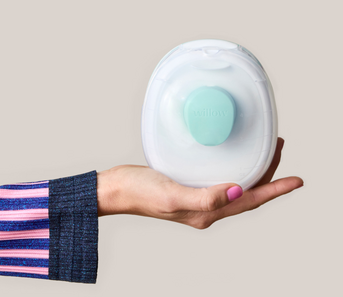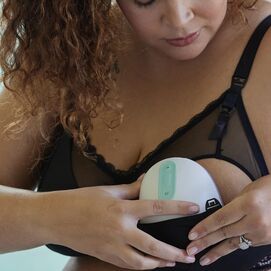There is nothing like that magical moment after you’ve brought your new little one home and it’s time to snuggle and feed them for the first time to help them grow big and strong. Milk supply can be a source of anxiety for excited new moms when their milk doesn’t arrive promptly after delivery. If you’re in this position, the truth is that there is no need to worry. No breast milk after delivery is a common problem amongst new mothers, and there are a wide variety of methods that can help to stimulate the necessary nutrients for your baby.
Bottom line is, no mama is a failure, and Willow has your back, so don’t give up on your body! Take a deep breath and keep reading to learn everything you need to know about breast milk production and the worry-free process to solving no breast milk after delivery.
What Stimulates Production of Breast Milk?
The process of milk production, or lactation, starts well before your baby is even born. In fact, breasts prepare for lactation as early as puberty! During pregnancy, hormone levels increase which causes an increase in breast tissue volume, and increases the production of the earliest stage of breast milk called colostrum. Once your baby is born, lactation is maintained by nipple stimulation, along with regular milk expressing and removal. Because of this, breast milk is produced on a “supply and demand” basis. Every time that you nurse or express milk, your body is signalled to produce more.
Not producing milk after delivery is common, and is not a reason to panic. Newborns typically want to sleep a lot and only need to survive on small amounts of colostrum in the following weeks after they are born. Colostrum is deemed as “liquid gold” for newborns because of its high density in important nutrients and antibodies. Even if you believe that your baby isn’t getting enough from your breasts, it’s important to keep pumping or feeding. This will send the important signal to your body that it needs to start supplying more, if the demand is high enough.
Misconceptions about low milk supply
Low milk supply is common, and there are many valid reasons for why it occurs. But there are some other reasons that are just misconceptions and can be easily debunked. Before giving up on your milk supply, be sure to check your facts. Here are the most common myths about low milk supply:
-
Overfeeding: Overfeeding your baby cannot affect your level of milk supply, although it is still possible to overfeed your baby. In fact, a rigorous feeding or pumping schedule can actually help to increase supply if the demand is high.
-
Small breasts: Nope, your breast size does not determine how much milk your breasts are capable of producing. However, women with larger breasts may be able to store more milk. This just means that women with smaller breasts may need to pump or feed more often.
-
Health Issues: Any external health issues like illness or injuries will not affect your milk supply. However, stress and fatigue are capable of negatively affecting milk production. Along with this, lifestyle choices like excessive smoking and drinking can also impact milk supply.
Willow 360™ Wearable Breast Pump
Willow 360™ Wearable Breast Pump
Willow 360 is designed with a zero-gravity latch to give you 360° of leak-proof mobility. It's the hands-free breast pump that changed the game.
Willow Go™ Wearable Breast Pump
Willow Go™ Wearable Breast Pump
With hospital-grade suction and a 100% comfort rating, Willow Go pumps quietly and discreetly (no dangling tubes, bottles, or external motors) so you can do it all.
How to tell if your baby is getting enough milk
Even if you think you aren’t producing enough milk, your baby may still be getting the perfect amount of nutrients they need to grow! It’s important to remember that pumping can be deceptive compared to breast feeding. It is common to pump less than if you were breastfeeding, but this doesn’t necessarily mean your baby isn’t getting enough to eat. Weight gain and wet diapers are two of the most effective ways to gauge your baby’s feeding progress.
Weight Gain
It’s helpful to weigh your baby each week to ensure they are growing at a healthy and normal weight. Their weight can also act as an indicator for how much nutrients they are or are not getting from your breast milk. Normal weight gain within the first three months is anywhere between 150 - 200 grams per week.
Wet Diapers
If your baby is wetting their diaper at least 5-6 times a day after the first week, chances are they are getting enough milk! If they aren’t wetting their diaper enough in the first week, this may be a sign that they aren’t getting enough to eat.
Signs Your Baby is Not Getting Enough Milk and They Might Be Dehydrated
If your baby is displaying any signs of dehydration and malnourishment, seek medical attention immediately. Below are the most common indicators:
Dark-colored urine
Urine that is a dark yellow or brown and is more concentrated is a clear indicator of dehydration for a baby.
Diarrhea or vomiting
Very watery or explosive poops are a sign of dehydration in a baby. Normal poops in newborns after a week should be mustard yellow, green, or brown. Vomiting more than just spit ups of milk can also be a sign of dehydration.
Dry mouth
Keep an eye out for cracked, bloody lips and a dry mouth on your baby. Dry mucous membranes, like dry eyes, are clear indicators of dehydration.
Fever
Fevers can actually be a cause for dehydration in babies, and can be the result of other illnesses. If your baby is displaying other symptoms of dehydration and has a fever, dehydration is likely the cause and you should seek medical attention immediately.
Lethargy
If your baby is tired and cranky, or doesn’t seem very playful for longer periods of time, chances are they are experiencing some dehydration.
Reluctance to feed
If babies are reluctant or refuse to breastfeed or feed from the bottle, they are likely not feeling very well and could be dehydrated. Be mindful of any other symptoms they are showing in case they are sick or have other feeding issues.
Yellowing of the skin or eyes (jaundice)
Jaundice creates a yellow pigment in the skin which is a byproduct of bilirubin, or old red blood cells. To test if your baby has jaundice symptoms, press lightly on their face. Your baby could have mild jaundice if the pressure leaves a lasting yellow mark. Jaundice is worsened by dehydration, but there are existing treatments for babies.
What Causes Little to No Breast Milk Production After Delivery?
There are many different causes that could result in no breast milk production after delivery, but some include:
Hormonal Imbalances
Various hormonal imbalances can contribute to no milk production after delivery. Treating these hormonal imbalances can help to boost milk production.
Diabetes or Gestational Diabetes
Women who have diabetes are more likely to have a lower milk supply. If you have diabetes, it’s important to make sure your diabetes is well controlled during pregnancy and after birth. This will help to ensure that the condition will not further negatively impact your milk supply and overall feeding experience with your baby.
Pituitary Gland issues
The pituitary gland plays an important role in lactation because it is responsible for releasing the hormone prolactin which helps stimulate milk production. Hypopituitarism is a pituitary gland disorder which can result in a prolactin production deficiency, leading to no milk supply after delivery. Hormone replacement therapy is the most common approach to solving this issue.
Thyroid Problems
The thyroid also is an important player for lactation because it secretes hormones that regulate prolactin production. When a woman’s thyroid malfunctions, this negatively impacts milk supply. Regularly testing your thyroid levels during pregnancy is a great way to ensure this does not happen.
Certain Medications + Herbs
Menthol, peppermint, sage, parsley, jasmine, and other herbs have proven to negatively affect milk supply. Medications like birth control pills and even sudafed have also been linked to low milk production. Be careful to limit your intake on these supplements and medications, especially when pregnant.
Ovarian Cysts and PCOS
Polycystic ovarian syndrome (PCOS) is common amongst the female population, and is something that should be monitored closely. PCOS and ovarian cysts create increases in the androgen hormone which can interfere with the production of prolactin. Early diagnosis and treatment can decrease the chances of it having long term negative effects on milk production.
Obesity
Women who are overweight or obese have lower prolactin responses when breastfeeding or pumping which can result in lower milk production. This means that women who are obese risk having virtually no lactation process.
Previous Breast Surgery
Both cosmetic and medical breast surgeries can have an impact on milk production. Their impact widely depends on how the procedure was done. If there was more damage to the breast during the surgery, the more likely complications will arise during nursing.
Stress and Anxiety
During the first few weeks of delivery, stress and anxiety have proven to be one of the top reasons why moms experience little to no milk supply. Seeking out help through a medical provider or therapist is a great initial start to helping treat those negative feelings.
Hormonal Birth Control
Hormonal birth control methods specifically made with estrogen will decrease a woman’s milk production. Starting birth control after delivery, or after the lactation process has started, will decrease the chances of the medication completely eliminating milk production. Remember that there are several other types of birth control, talk to your healthcare provider to determine which is the best for you.
If you had a difficult delivery
Labor interventions can impact breastfeeding, but there are a variety of steps you can take to overcome any of those issues. Interventions like early separation, premature births, and caesarean sections have proven to cause delays in production. In these scenarios, pumping is recommended as a way to ensure you send signals to your body that it needs to start producing milk. Skin to skin contact with your baby is also a highly beneficial signal for your body to start the process.
Ways to improve breast milk flow
Massage the breast area
Massaging both breasts before you pump or feed helps to stimulate milk production and increase milk supply. Use a slow, circular motion with your finger tips, starting from the top of the breast and working outwards. Focus on relaxing into the sensation!
Use a hospital grade pump
Hospital grade pumps are the most powerful pumps available, made with a durable motor that pumps milk effectively and efficiently. These pumps are a perfectly suitable option for moms who have a low milk supply. Hospital grade pumps are designed to increase your milk production by mimicking your baby’s feeding stimulation and schedule.
Express and pump frequently
Creating a strict and frequent pumping regimen will send a signal to your body that milk is in high demand. Remember that milk production is on a supply and demand basis, so if you have an infrequent pumping schedule, the less likely your milk supply will begin to increase. Even if you think you aren’t pumping enough, stay on a frequent schedule.
Implement a self care routine by drinking water and sleeping well
We know that stress and dehydration can negatively affect milk production. Because of this, it’s important to make sure you’re staying hydrated and rested. Work with your partner to create a feeding plan that allows you to get some rest each night. Mamas are busy, but taking care of yourself is one of the best ways to stimulate your milk production.
Use a heating pad or take a warm shower before expressing milk
Gently applying heat to your breasts before expressing milk can stimulate the “let down” period, which can increase milk flow during feeding. The warm sensation is aimed to relax your body, because the let down period is less likely to occur if you are tense or anxious.
For all the mamas out there, we know that no breastmilk after delivery can be stressful! The reality is that this is completely normal and is something that many new moms struggle with. At Willow, we want to support you in every step of the lactation process, because we want you to have a wonderfully positive experience! Whether you’re a new mama or expecting, visit our store to learn more about how Willow can be your new best friend.















